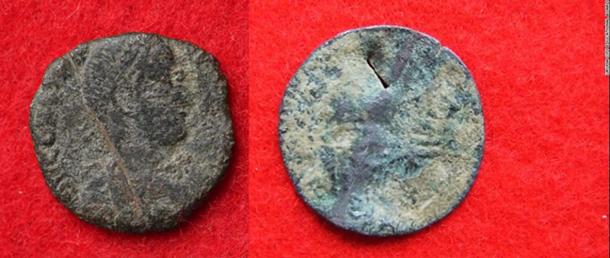
Roman Coins Discovered at Japanese Castle Raise Questions of Ancient Connections
Four Roman copper coins have been unearthed at Katsuren Castle on Okinawa Island, Japan. They are the first of their kind to be discovered in the country and have been dated to 300-400 AD. How the coins came to be at the castle is still a mystery.
According to Seeker, it was first believed that the coins were simply pennies dropped by U.S. soldiers, but washing them showed images of the Roman Emperor Constantine I. Archaeologist Hiroki Miyagi said that the discovery came as a shock and the Independent claims that the coins “were originally thought to be a hoax.”

Two artifacts found at Katsuren Castle: A Roman coin (Uruma Board of Education) and an Ottoman coin. (Uruma Board of Education)
Japan Times reports that the coins measure 1.6-2 cm (0.6-0.8 inches) in diameter. The designs on the coins are hard to see due to abrasion, however by using x-ray analysis, the researchers found depictions of a soldier holding a spear and the emperor Constantine I. The coins will be on display at Uruma City Yonagusuku Historical Museum in central Okinawa until Nov. 25.
Apart from the Roman coins, the researchers also found a coin from the 17th century Ottoman Empire. Five other possible coins have also been discovered at the castle since excavations began there in 2013.
- The Seven-Branched Sword: The Mystical Ceremonial Sword of Japan
- Beware of the Cat: Tales of the Wicked Japanese Bakeneko and Nekomata – Part 1

Excavations at the site. (Urama Board of Education)
Katsuren Castle was built sometime in the late 13th - early 14th century, and it was abandoned about 200 years later. The castle ruins received UNESCO recognition in 2000. Japan-guide.com tells one of the most famous legends of the castle. It is associated with Lord Amawari, who was the 10th lord of the castle. They write “Amawari was a sickly child that got abandoned in the mountains to die. However, the child survived and grew into a powerful leader who defeated an oppressive lord and took over Katsuren Castle.”
Jcastle provides more of Amawari’s tale and says that:
“He is famous for fostering prosperous international trade and many shards of Chinese pottery and tiles were found on the site of Katsuren Castle. He was also a cunning and deceiving lord. It is said that he pushed the 9th lord Mochizuki Aji off the top of the walls when he tricked Mochizuki to come up there one night and thus assumed lordship of the castle. Mochizuki was considered to be a tyrant so Amawari was a savior to the people of Katsuren. As his strength grew, Lord Gosamaru was moved to Nakagusuku Castle to keep Awamari in check. Awamari deceived the king in Shuri that Gosamaru was the bigger threat and got his support to defeat Gosamaru. Later, he also planned to seize control of the whole kingdom and overtake the king at Shuri, but this time the king was warned in time and Amawari was defeated. Some stories say it was Amawari's wife (the king's daughter) who found out about the plot and warned her father in time. After Amawari, no powerful lords rose from Katsuren Castle.”
- A Surprising Japanese Interpretation of the Lost Years of Jesus Christ
- Glass shard found at Japanese shrine matches artifacts from Persian Royal Palace

The dress of Oji and Aji in Ryukyu Kingdom. (Public Domain)
Although the feudal lord was linked with international trade, no evidence of connections with Europe have been found before the present discovery of the coins. Miyagi offers one possible explanation for where the coins may have been before they arrived at the castle: "East Asian merchants in the 14 and 15th centuries mainly used Chinese currency, a round coin with a square hole in the middle, so it is unlikely that the Western coins were used as a means of currency. I believe they probably got the coins in Southeast Asia or China."
Could this suggest Romans had connections or even direct influence on ancient Japan? MessageToEagle.com believes so, and writes “Ancient Romans obviously visited the Katsuren Castle in Japan.” They point to previous evidence of three Roman glass beads found in a 5th century Kyoto burial, as more proof of possible connections. Speaking on the beads, researcher Tomomi Tamura said “They are one of the oldest multilayered glass products found in Japan, and very rare accessories that were believed to be made in the Roman Empire and sent to Japan.”

A glass bead that was made by Roman craftsmen - found in an ancient tomb at Nagaokakyo near Kyoto. (Nara National Research Institute)
The board of education in the city of Uruma echoes Tomomi Tamura by saying that the recent discovery of the Roman coins is “precious historical material suggesting a link between Okinawa and the Western world.” How close that link may have been is still debated.
Top Image: Katsuren Castle, Uruma, Okinawa Prefecture, Japan. (kanegen/CC BY 2.0) Insert: A 4th-century copper coin from ancient Rome found at the castle. (Uruma Board of Education)















